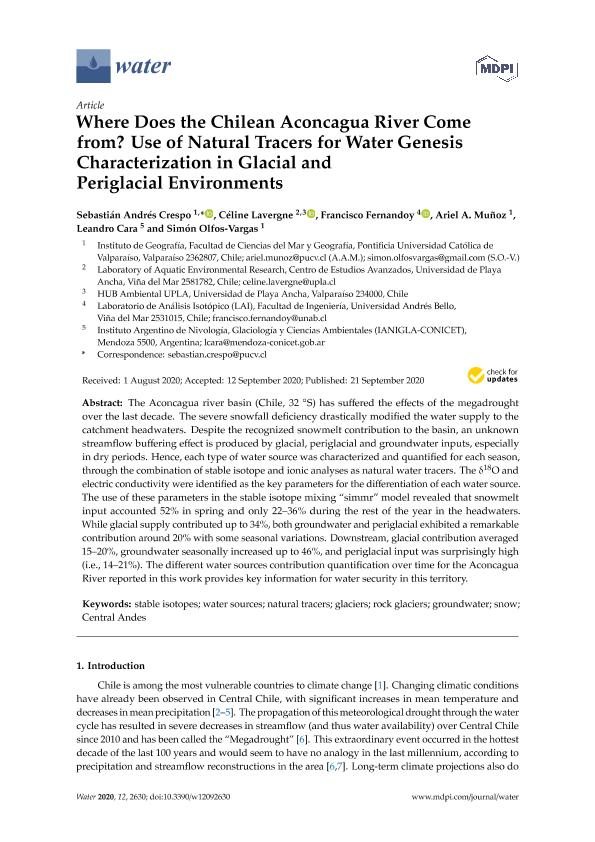Mostrar el registro sencillo del ítem
dc.contributor.author
Crespo, Sebastián Andrés

dc.contributor.author
Lavergne, Céline
dc.contributor.author
Fernandoy, Francisco
dc.contributor.author
Muñoz, Ariel A.
dc.contributor.author
Cara Ramirez, Leandro Javier

dc.contributor.author
Olfos Vargas, Simón
dc.date.available
2021-10-07T14:14:52Z
dc.date.issued
2020-09
dc.identifier.citation
Crespo, Sebastián Andrés; Lavergne, Céline; Fernandoy, Francisco; Muñoz, Ariel A.; Cara Ramirez, Leandro Javier; et al.; Where does the chilean aconcagua river come from? Use of natural tracers for water genesis characterization in glacial and periglacial environments; Molecular Diversity Preservation International; Water; 12; 9; 9-2020; 1-18
dc.identifier.issn
2073-4441
dc.identifier.uri
http://hdl.handle.net/11336/143102
dc.description.abstract
The Aconcagua river basin (Chile, 32◦S) has suffered the effects of the megadrought over the last decade. The severe snowfall deficiency drastically modified the water supply to the catchment headwaters. Despite the recognized snowmelt contribution to the basin, an unknown streamflow buffering effect is produced by glacial, periglacial and groundwater inputs, especially in dry periods. Hence, each type of water source was characterized and quantified for each season, through the combination of stable isotope and ionic analyses as natural water tracers. The δ18O and electric conductivity were identified as the key parameters for the differentiation of each water source. The use of these parameters in the stable isotope mixing “simmr” model revealed that snowmelt input accounted 52% in spring and only 22–36% during the rest of the year in the headwaters. While glacial supply contributed up to 34%, both groundwater and periglacial exhibited a remarkable contribution around 20% with some seasonal variations. Downstream, glacial contribution averaged 15–20%, groundwater seasonally increased up to 46%, and periglacial input was surprisingly high (i.e., 14–21%). The different water sources contribution quantification over time for the Aconcagua River reported in this work provides key information for water security in this territory.
dc.format
application/pdf
dc.language.iso
eng
dc.publisher
Molecular Diversity Preservation International

dc.rights
info:eu-repo/semantics/openAccess
dc.rights.uri
https://creativecommons.org/licenses/by-nc-sa/2.5/ar/
dc.subject
CENTRAL ANDES
dc.subject
GLACIERS
dc.subject
GROUNDWATER
dc.subject
NATURAL TRACERS
dc.subject
ROCK GLACIERS
dc.subject
SNOW
dc.subject
STABLE ISOTOPES
dc.subject
WATER SOURCES
dc.subject.classification
Oceanografía, Hidrología, Recursos Hídricos

dc.subject.classification
Ciencias de la Tierra y relacionadas con el Medio Ambiente

dc.subject.classification
CIENCIAS NATURALES Y EXACTAS

dc.title
Where does the chilean aconcagua river come from? Use of natural tracers for water genesis characterization in glacial and periglacial environments
dc.type
info:eu-repo/semantics/article
dc.type
info:ar-repo/semantics/artículo
dc.type
info:eu-repo/semantics/publishedVersion
dc.date.updated
2021-09-06T19:59:48Z
dc.journal.volume
12
dc.journal.number
9
dc.journal.pagination
1-18
dc.journal.pais
Suiza

dc.journal.ciudad
Basel
dc.description.fil
Fil: Crespo, Sebastián Andrés. Consejo Nacional de Investigaciones Científicas y Técnicas. Centro Científico Tecnológico Conicet - Mendoza. Instituto Argentino de Nivología, Glaciología y Ciencias Ambientales. Provincia de Mendoza. Instituto Argentino de Nivología, Glaciología y Ciencias Ambientales. Universidad Nacional de Cuyo. Instituto Argentino de Nivología, Glaciología y Ciencias Ambientales; Argentina. Pontificia Universidad Católica de Valparaíso; Chile
dc.description.fil
Fil: Lavergne, Céline. Universidad de Playa Ancha; Chile
dc.description.fil
Fil: Fernandoy, Francisco. Universidad Andrés Bello; Chile
dc.description.fil
Fil: Muñoz, Ariel A.. Pontificia Universidad Católica de Valparaíso; Chile
dc.description.fil
Fil: Cara Ramirez, Leandro Javier. Consejo Nacional de Investigaciones Científicas y Técnicas. Centro Científico Tecnológico Conicet - Mendoza. Instituto Argentino de Nivología, Glaciología y Ciencias Ambientales. Provincia de Mendoza. Instituto Argentino de Nivología, Glaciología y Ciencias Ambientales. Universidad Nacional de Cuyo. Instituto Argentino de Nivología, Glaciología y Ciencias Ambientales; Argentina
dc.description.fil
Fil: Olfos Vargas, Simón. Pontificia Universidad Católica de Valparaíso; Chile
dc.journal.title
Water
dc.relation.alternativeid
info:eu-repo/semantics/altIdentifier/url/https://www.mdpi.com/2073-4441/12/9/2630
dc.relation.alternativeid
info:eu-repo/semantics/altIdentifier/doi/http://dx.doi.org/10.3390/w12092630
Archivos asociados
